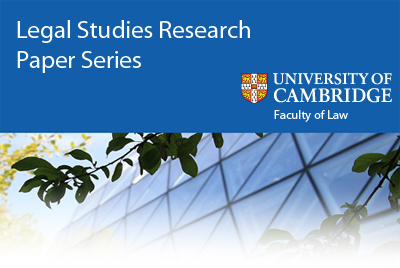 The Faculty has published Volume 9 Number 8 of the University of Cambridge Faculty of Law Legal Studies Research Paper Series on SSRN.
The Faculty has published Volume 9 Number 8 of the University of Cambridge Faculty of Law Legal Studies Research Paper Series on SSRN.
This issue includes the following articles:
P G Turner: Lex Sequitur Equitatem: Fusion and the Penalty Doctrine (31/2018)
Since an early article of Professor Brian Simpson’s, the opinion of historians and lawyers has been that the penalty doctrine which disallows the enforcement of penal stipulations in voluntary transactions derives from a fusion of law and equity. Specifically, the doctrine derives from ‘fusion by convergence’: the independent development by separate courts of law and courts of equity of similar rules concerning relief from penalties.
Under Simpson’s account, the penalty doctrine has become a model of the fusion of law and equity dating to the life of equity’s ‘father’, Lord Nottingham. On that account, after transacting parties began using them in the fourteenth century, English law condoned the use of penalties in voluntary transactions for upwards of one century. Slowly the Court of Chancery found situations in which it would be inequitable to condone the penalty: at first because of special circumstances, later simply because the penalty was a penalty. The common law soon followed, inverting the maxim aequitas sequitur legem. By the last quarter of the seventeenth century, the common law courts routinely relieved against penalties, and by the turn of the nineteenth century had taken over the bulk of such litigation. The penalty doctrine became a common law doctrine solely or nearly so.
Half a century after its publication, Simpson’s thesis requires examination. This paper suggests that Simpson’s account and the current understanding that flows therefrom are false. On the basis of a fuller examination of printed and unprinted reports and manuscript sources of the Court of King’s Bench and Court of Chancery than previously made, this paper redraws the account of the development of the penalty doctrine. The evidence shows that: penalties were routinely enforced in common law courts until the end of the eighteenth century; all “common law” relief in the royal courts depended on statutes under which the judges applied equitable principles borrowed from the Court of Chancery; reliance on statutory power to grant relief at common law continued after 1875 in “Judicature Act courts”; but the repeal of those statutes means that the only source of principle for relief from penalties in England today are principles of equity.
Simpson’s suggestion that the penalty doctrine is a product of “fusion” is mistaken: in the modern period, there has been no judge-made common law of relief from penalties with which the equitable doctrine could fuse. As Parliament has directed that those equitable principles shall continue to apply, fusion is a distraction from the application and development of the (equitable) penalty doctrine.
Simon Deakin & Christopher Markou: The Law-Technology Cycle and the Future of Work (32/2018)
Features of the ‘fourth industrial revolution’, such as platforms, AI and machine learning, pose challenges for the application of regulatory rules, in the area of labour law as elsewhere. However, today’s digital technologies have their origins in earlier phases of industrialisation, and do not, in themselves, mark a step change in the evolution of capitalism, which was, and is, characterised by successive waves of creative destruction. The law does not simply respond to technological change; it also facilitates and mediates it. Digitalisation, by permitting the appropriation of collective knowledge, has the capacity to undermine existing forms of regulation, while creating the space for new ones. It may erode the position of some professions while enabling others, complementary to new technologies, to emerge. It is unlikely to bring about the redundancy of forms of labour law regulation centred on the employment relationship. We appear to reaching a point in the law-technology cycle where push-back against regulatory arbitrage can be expected.
Tanya Aplin & Lionel Bently: Displacing the Dominance of the Three-Step Test: The Role of Global, Mandatory Fair Use (33/2018)
Article 10(1) of the Berne Convention mandates a quotation exception that is broad in scope, one that is not limited by work, nor type of act, nor by purpose, and is only subject to the conditions in Article 10, namely, the work has been lawfully made available to the public, attribution, fair practice, and proportionality. We call this “global, mandatory fair use”. This overlooked norm in international copyright law is unaffected by and distinct from the three-step test and, as such, potentially dislodges its dominance. In turn, this creates different possibilities for how to conceive of and assess copyright exceptions at national level. To substantiate our argument, this chapter is structured in three parts. Part I outlines our underpinning contention, namely, that Article 10(1) creates a global, mandatory “fair use” type obligation. Part II explains why this obligation is unaffected by the three-step test in international copyright law. Finally, in Part III, we draw out the differences between Article 10(1) and the three-step test and illustrate the potential relevance of this for national law using the specific case of U.S. “fair use”.
Tanya Aplin & Lionel Bently: Whatever Became of Global Mandatory Fair Use? A Case Study in Dysfunctional Pluralism (34/2018)
The international copyright system requires all participants to recognise a freedom for fair quotation that covers much of the ground encompassed by the notion of ‘fair use.’ The obligation derives from Article 10(1) of the Berne Convention and thus applies to some 174 countries (and, because Article 10(1) must be complied with under TRIPS, is carried over into the WTO Agreement). In contrast to other limitations in Berne, Article 10(1) is not optional, it is mandatory. It creates an obligation, and thereby imposes a ceiling on the freedom of action of Members of the Union. The breadth of the obligatory exception is wide: as enacted in national law, it should not be limited by work, nor by type of act, nor by purpose. The exception should not be subjected to additional conditions beyond those recognised in Article 10: to do so is to breach the obligation. Subject to those conditions, the freedom the Article secures to users encompasses any and every act of quotation, the meaning of which reflects how the term is ordinarily used across all cultural forms. That includes free-standing uses, transformative uses and parodic uses. Its breadth reflects, but is not limited by, the desire to give effect to the fundamental freedom, freedom of expression. We have dubbed this ‘global, mandatory, fair use’, or GMFU, for short.
Yet, despite this obligation, there has been a marginalisation of Article 10(1) and this paper explores how, and why, this distortion of international obligations has occurred. It suggests the dangers of pluralism in copyright when it comes to international obligations.
Julia Powles & Johnathon Liddicoat: United Kingdom Patent Decisions 2017 (35/2018)
This report highlights the main UK patent decisions from 2017, including a major Supreme Court infringement case introducing a doctrine of equivalents, the first ruling on FRAND royalty rates and injunctions, compensation for employee inventors, legal priority, patentable subject matter, and a novel, unsuccessful attempt by the State to sue a pharmaceutical company whose invalid patents delayed the entry of generics.
Interested readers can browse the Working Paper Series at SSRN, or sign up to subscribe to distributions of the the e-journal.


 Facebook
Facebook  X/Twitter
X/Twitter  Instagram
Instagram  YouTube
YouTube  Flickr
Flickr  LinkedIn
LinkedIn